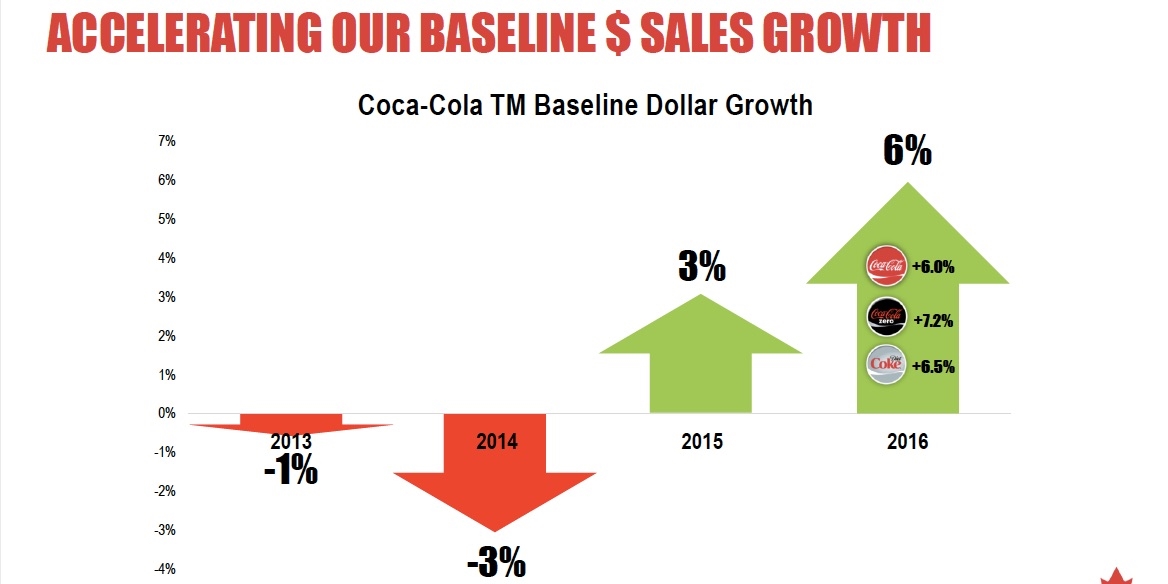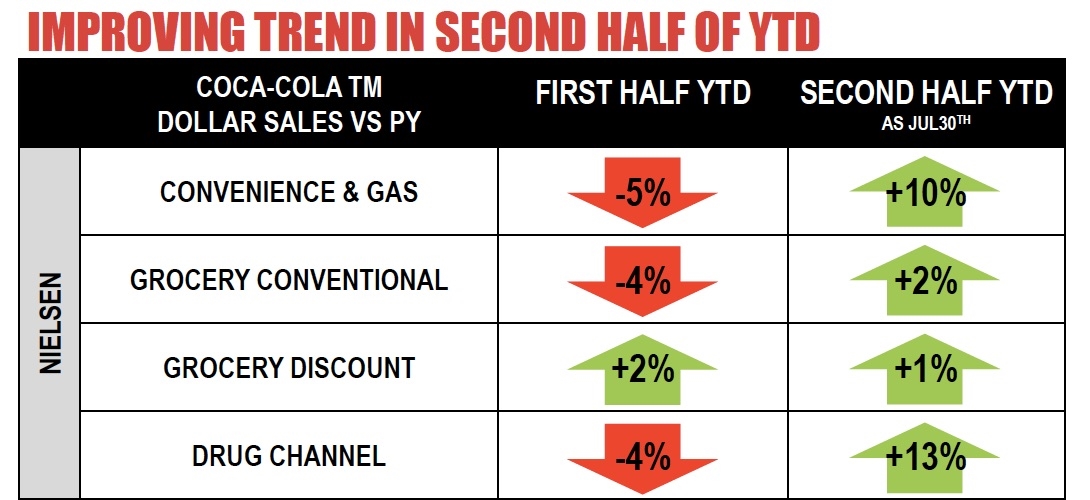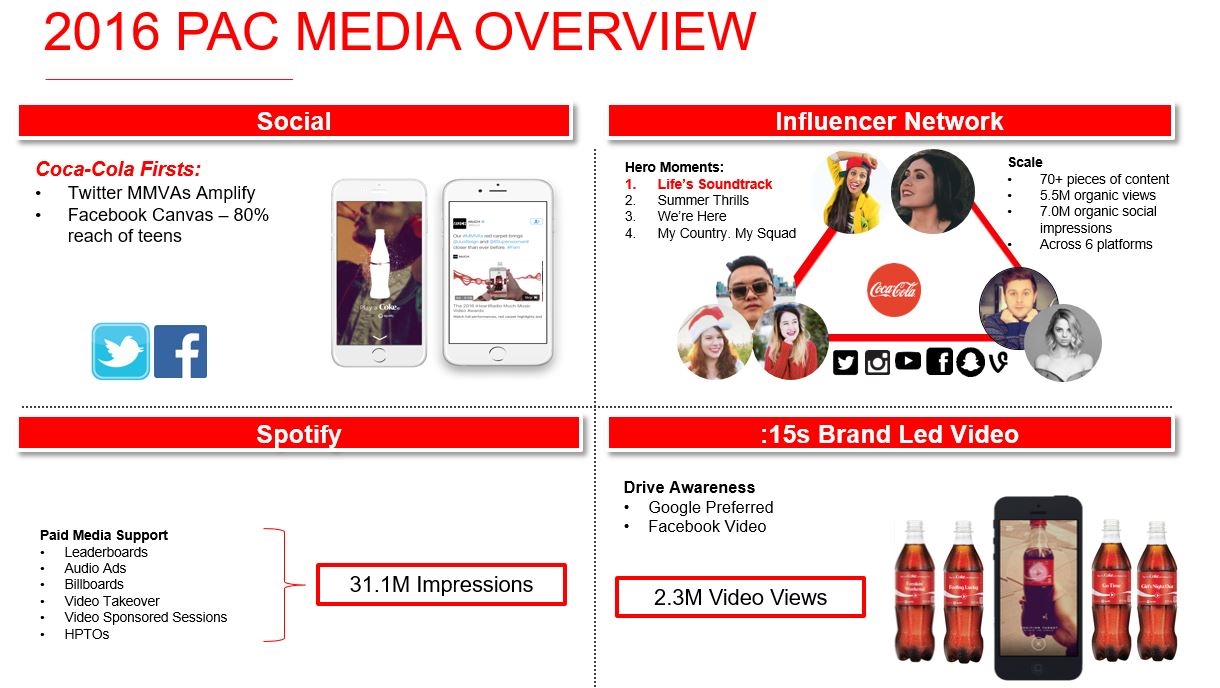Seasonal (BRONZE)
Client Credits: Coca-Cola Canada
Beth MacGibbon, Strategic Marketing Manager
Diego Moratorio, Director of Marketing
Mike Samoszewski, VP Sparkling
Agency Credits: The Hive
Simon Creet, Partner, CCO, The Hive
Trent Fulton, Partner, Managing Director
Brad Van Schaik, Associate Creative Director
Candice Lennox, Account Supervisor
Becca O’Donovan, Account Coordinator
Sumit Ajwani, Producer
Jam 3, App Development
Gravity, Microsite Development
Cynthia Steele, Director Connection Planning, UM
Jennifer Thompson, UM
Supergroup, Music Consultant
Section I — CASE PARAMETERS
| Business Results Period (Consecutive Months): | May-July 2016 |
| Start of Advertising/Communication Effort: | April 1, 2016 |
| Base Period as a Benchmark: | May-July 2015 |
| Geographic Area: | National |
| Budget for this effort: | $2 – $3 million |
Section IA — CASE OVERVIEW
Why should this case win in the category (ies) you have entered?
Coca-Cola is an icon. And as an icon we need to behave like one. So this means being innovative, cool, authentic and a leader. Over the years Coca-Cola has demonstrated this time and time again. However, doing this with a Teen target is another ballgame altogether.
Teens don’t want to be sold to, which means we need to insert ourselves naturally into their day as the enabler of the moment rather than the author – by tapping into a behavior that they’re already doing rather than telling them they need to do something different. This is the best way to truly recruit brand advocates instead of in-and-out promo advocates.
We all know it isn’t enough to simply appear once a year, even if brands come out with great prizing, it’s just not ownable and rarely does it impact equity. Coca-Cola wants to build a meaningful relationship with this target consumer and to show them who they really are.
This case demonstrates Coca-Cola’s success in doing just that.
Section II — THE CLIENT’s BUSINESS ISSUES/OPPORTUNITIES
a) Describe the Client’s business, competition and relevant history:
| Teens. Is there a more elusive target? Yet they are crucial to the growth of sparkling beverages with the category vying for their attention seemingly at every turn. Making it hard to get noticed and even harder to make a significant connection with them.
Over the years Coca-Cola has pushed themselves to offer true value for this target – the most notable example being the ‘Share a Coke’ campaign, which put consumer’s names on bottles and cans for the first time. The program was quite successful and generated a 1.8% increase in buying occasions for 500mL bottles. More than that, it demonstrated the success you can have when you connect with your consumer in an authentic way. As a result, Coca-Cola was keen to build on this momentum and develop a new initiative for the Summer of 2016 that built on its recent achievements and helped recruit a new generation of Teens and of course deliver on aggressive sales targets. |
b) Describe the Client’s Business Issues/Opportunities to be addressed by the campaign:
|
A good place to start reaching any consumer base is by taping into their interests. Music is the #1 Teen passion point, it allows them to connect closer with one another and it helps them shape and express their identities. More importantly, music has been and will always be a key influencer on Teens’ behavior and choices. Making it a crowded territory. Moreover, music consumption is shifting with streaming services on the rise and Teens streaming 27,000 hours of music every month. Spotify is now the second biggest revenue-generator for labels. There was an opportunity to use this strategic partnership and build something together that would hopefully leave a lasting impression on the target. |
c) Resulting Business Objectives: Include how these will be measured:
The objective was to develop an idea with music at the centre, with the challenge to drive brand love and disrupt in a highly crowded space.
Moreover, the client had an aggressive objective of increasing Incidence Growth year over year by +2pts and increasing Favourite Brand amongst Teens by +1.5pts (vs. 2015).
There was also a lot of discussion about developing a proprietary app. Would teens want to download Coca-Cola’s app? We believed they would if it truly provided value and a KPI of 25,000 downloads was given to us as an objective.
From there we set off to create something truly unique and innovative.
Section III — YOUR STRATEGIC THINKING
a) What new learnings/insights did you uncover?
| As we stated there’s no disputing the connection between music and our core target, Teens (14-19). However, standing out in this space and truly connecting is another thing altogether. Simply stated, we needed to ensure that Teens remembered Coca-Cola throughout the experience.
There is no denying Coca-Cola’s ubiquitous presence in the lives of Teens. We know that music is ever present as well. Simply stated, if we know that music is in one hand and a Coca-Cola beverage is in the other, how could we connect the two in a truly innovative and meaningful way? That was the key that unlocked everything. We didn’t need to give Teens the chance to win a big music experience like a concert or a festival, we simply needed to embrace the existing relationship between target, brand and music. What do we mean? Music and Coca-Cola are naturally a part of summer occasions. From road trips with friends to hanging on the beach, Coca-Cola is often along for the ride. But what if it could play an even bigger part? |
b) What was your Big Idea?
For the first time in the history of the brand, we let consumers not only drink a Coke but also gave them the ability to Play a Coke and became the soundtrack for Summer 2016.
c) How did your Communication strategy evolve?
|
We knew we needed to move the brand from supporting role to catalyst and needed to create Working with Spotify, we created a way to capitalize on the natural way Teens are consuming music and connect the brand to it in innovative and ownable way. The idea to give every 500mL Coca-Cola its very own playlist was born.
|
d) How did you anticipate the communication would achieve the Business Objectives?
|
While the attention span of our target is almost non-existent, we know that they are not impossible to reach. Teens are experimental, innovative and they love to discover new things. We knew if we could leverage these insights, we would have a good chance at achieving our objectives. As stated earlier, Coca-Cola 500 mL bottles were given their own exclusive playlist/soundtrack. We took this initiative one step further and curated the playlists according to mood and occasions. When consumers downloaded the Play-a-Coke app, a Spotify playlist exclusive to that Coca Cola bottle’s occassion/mood, played on their phone. Over 180 playlists in English Canada and Quebec were created, giving Teens the ability to save each one of them to their Spotify accounts, making Coca-Cola the soundtrack to their summer. However, we didn’t stop there. We also made the experience even more interesting by allowing consumers to toggle between songs on the playlist by simply twisting the bottle in their hands. This feature helped ensure that the experience would be fresh and different. How sweet is that? |
Section IV — THE WORK
a) How, where and when did you execute it?
| Play a Coke was executed during the Summer of 2016. To say that this program was non traditional is an understatement. The app and the 500 mL bottles were the communication heroes of the program vs. advertising.
While ads ran on Spotify and video posts were on social platforms (Twitter and Facebook)and digital pre-roll, the communication was primarily educational. Meaning the messaging was developed to drive awareness but more importantly the ads served as tutorials for the experience. However as stated previously, the crux of the idea was in the packaging itself. We were able to change the look of the label to showcase the program. This along with the custom occassions/moods allowed for disruption at shelf level. Moreover we gave social media influencers their own bottles to help us spread the word and used strategic partnerships to also help drive awareness. Below is a good flow of the experience and shows how it was executed and worked in market.
|
c) Media Plan Summary
See below for the plan:
Section V — THE RESULTS
a) How did the work impact attitudes and behaviour?
| The program has been a great success for the brand. While the promotional campaign drove sales and share, it also managed to aid in the growth of intrinsic attributes like ‘Great Tasting’ and ‘Refreshing’ which all drive Coca-Cola’s overall brand health. |
b) What Business Results did the work achieve for the client?
| The following results were cpatured from the July2nd, Bev360 PE June30th, Coca-Cola Snap App dashboard report. The previous year’s summer months were used as a benchmark to determine success.
Share Gain: +.9pts over Share a Coke’s results (versus previous period in 2015) Instant Consumption (500mL) +1.6 (versus previous period in 2015) Met the Incidence Growth objective of +2pts (versus previous period in 2015) Doubled the Favourite Brand Score objective: +4pts, App Downloads 122,500 vs KPI of 25,000 Great Tasting Gap +2.0 pts (vs. previous period 2015) Refreshing Gap +2.0 pts (vs. previous period 2015) |
c) Other Pertinent Results
Coca Cola’s baseline growth is up +3 pts vs 2015. Play A Coke was a significant contributor to this success – source Neilsen July 30, 2016

d) What was the campaign’s Return on Investment?
Coca-Cola does not share this information.
Section VI — Proof of Campaign Effectiveness
a) Illustrate the direct cause and effect between the campaign and the results
Play A Coke was Coca-Cola’s sole promotional effort. It’s efforts can be seen by looking at the brand’s share performance by channel at the beginning of the year vs when we were in market:
Source: AC Neilsen, latest 13 weeks, July 30, 2016

b) Prove the results were not driven by other factors
Campaign spend vs. history and competition:
Share a Coke (previous summer’s campaign) had a similar spend.
Pre-existing Brand momentum:
Coca-Cola advertises regularly. It can be said that there is always brand momentum. However, the results of this initiative speak for themselves. They contributed to the brand’s equity, increased share and incidence.
We used the previous period (Summer 2015) to highlight the success of Play a Coke as Coca-Cola would have had similar promotional brand activity in market during last summer as well.
Pricing:
The pricing of Coca-Cola did not change during this time.
Changes in Distribution/Availability:
While there were no changes in distribution, Coca-Cola launched LTO flavour, Vanilla. This flavour was given a generic label and not featured in the communication -meaning Coca-Cola, Diet Coke and Coke Zero led the program. Consumers would have had to discover that Vanilla Coke was a part of the program once in the app itself, illustrating that it was not a driver of the program
Unusual Promotional Activity:
N/a
Any other factors:
N/a


